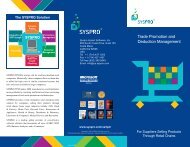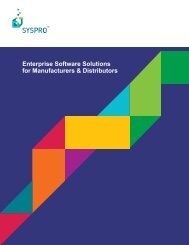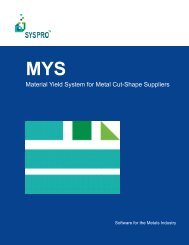Teach Yourself e.net - Syspro
Teach Yourself e.net - Syspro
Teach Yourself e.net - Syspro
You also want an ePaper? Increase the reach of your titles
YUMPU automatically turns print PDFs into web optimized ePapers that Google loves.
More Advanced Options<br />
The data is exactly the same in both XML files. The only difference is how the data has<br />
been arranged. This is a very simple example of the power of XSLT. Once we have<br />
learned more about how to process XML files using an XSLT processor and definition<br />
file, we will be using XSLT transformations to present XmlOut data in HTML format.<br />
6.1.2. The Process of Transforming<br />
The process of transforming an XML document into another format, such as HTML,<br />
requires two types of processing engines. We first need a parser capable of loading the<br />
source XML document into a DOM (Document Object Model) tree structure. The XSLT<br />
document is also loaded into the parser and a tree structure created for it. This tree<br />
structure will normally be optimized to accommodate XSLT processing and is specific to<br />
the processor being used. We then need an XSLT processor to take the XML document<br />
structure and match up the nodes within the document against the various &templates"<br />
found in the XSLT document structure, and then output the result. The final tree structure<br />
(the output) is dynamically created based on information contained within the XSLT<br />
document. Here is a simple diagram of the transformation process:<br />
Figure 6.1. The XSLT transformation process.<br />
6–3










